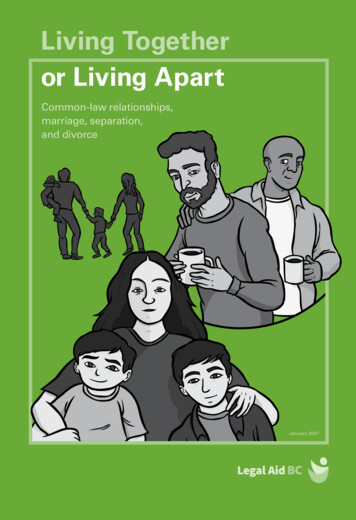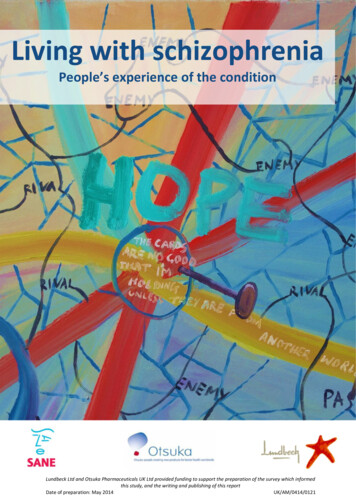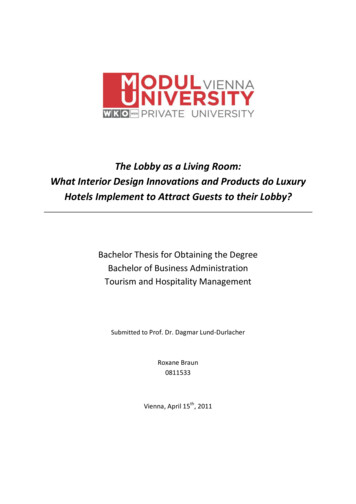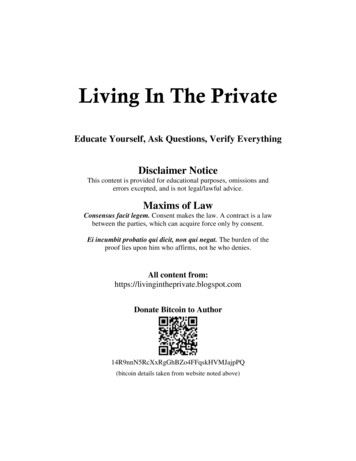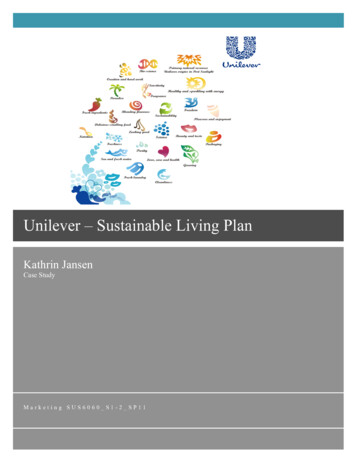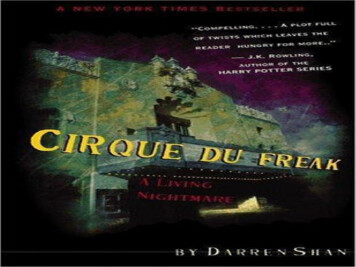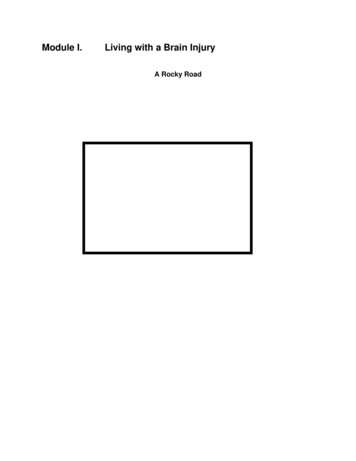
Transcription
Module I.Living with a Brain InjuryA Rocky Road
Module I - Living with a Brain InjuryPage 2 of 36Instructions to this module/Suggested Activities:-Please read and study this module.Since this module includes a lot of medical terms, the ABI Program Directorwould like to hold a couple of phone conversations with you so that you feel morecomfortable with the content. Please contact the ABI Program Director at (801)538-8244.Objectives of this module:a)b)c)d)e)Understand the consequences of Brain Injury and how it can affect aperson.Understand the distinction in between Acquired Brain Injury (ABI) andTraumatic Brain Injury (TBI).Understand brain functions.Understand the interactions of behavior, the environment, and brainchemistry.Understand the impact of drugs and alcohol.
Module I - Living with a Brain InjuryPage 3 of 36StatisticsThe following information was contributed by the Brain Injury Association of d.pdfs/2002FactSheetBrainInjury.pdf
Module I - Living with a Brain InjuryNote: for copyright information, please see the end of Module I.Page 4 of 36
Module I - Living with a Brain InjuryPage 5 of 36Understanding Brain InjuryThere are hundreds of different types of brain injuries.Traumatic Brain Injury (TBI)A Traumatic Brain Injury is an injury to the brain, not of degenerative or congenitalnature, that is caused by an external physical force that may produce a diminished oraltered state of consciousness. The result is an impairment of cognitive abilities orphysical functioning. It can also result in the disturbance of behavioral or emotionalfunctioning.There are two types of Traumatic Brain Injuries:Closed Brain Injury- This means that the injury occurred without physical penetrationof the skull. Although the brain is not directly “touched” during the injury, the brain floatsin fluid within the skull, and can bounce and twist within theskull, resulting in bruising and tearing from sharp bone on the inside of the skull.There are a variety of forces that cause damage in a closed brain injury. They include: Damage at the site of the blow (coup). The brain is compacted by molding of the bone inward. Pressure on the brain at the time of the coup may force the brain against theopposite side of the skull, producing additional contusions (counter-coup). Movement may cause a twisting or shearing of the nerve fibers, producingmicroscopic lesions. Bruises and strains may produce bleeding (hemorrhage), once the blood istrapped in the skull, this mass exerts pressure on surrounding structures. Blows to the head can produce edema (brain swelling), which could causeanother source of pressure on the brain.Open Brain Injury- This means that due to some type of blunt-force trauma, the skullwas fractured and/or penetrated. Examples of this could be a gunshot to the head orhaving severe fractures due to a motorcycle or automobile accident.No two traumatic brain injuries are the same. This is because for each individual,different areas of the brain are affected based on their particular injury. Other factorsthat affect the outcome are possible medical complications, the age of the person,current and former health status, and preexisting intellectual and personalitycharacteristics.Brain damage can result due to the direct or indirect causes noted below:PRIMARY INJURY : ACCELERATION-DECELERATION MOVEMENT: Theskull is pretty hard and inflexible. The brain is rather soft, like firm Jello. When theskull makes a rapid movement, it moves as a solid object. The brain, encasedinside the skull, moves at a different rate than the skull because it is soft. Inaddition, different parts of the brain move at different speeds due to their relative
Module I - Living with a Brain InjuryPage 6 of 36lightness or heaviness. The differential movement of the skull and brain when thehead is struck results in direct brain injury from three main causes: AxonalShearing, Contusion (bruising), and brain swelling (Cerebral Edema).1) AXONAL SHEARING: When the brain is slammed back and forth inside theskull after a head trauma, it is alternatively compressed and stretched because ofits soft, Jello-like structure. The long, fragile axons of the neurons that make upthe brain are also compressed and stretched. If the impact is severe enough,axons can be stretched until they are torn. This is called Axonal Shearing. If thisoccurs, the neuron dies. After a severe traumatic brain injury, there is massiveaxonal shearing and neuron death. This is a major cause of brain damage after atraumatic brain injury and cannot be directly treated.2) BRAIN SWELLING (CEREBRAL EDEMA): The brain also swells after asevere trauma, just like any other part of the body. This is a major cause of braindamage after traumatic brain injury.Severe swelling can cause death bycompressing the brain stem. Brain swelling can lead to neuron damage bysqueezing the cells or from ANOXIA caused by disrupting the flow of blood andoxygen to the brain.3) CONTUSION: The brain's violent slamming against the bones of the skullcan also result in contusions, bruising, and bleeding. This results in the tearing ofsmall blood vessels. It can also result in the death of neurons and is the secondleading cause of neuron death after a traumatic brain injury. Small contusions areusually not treated (concussion) if blood flow is interrupted.Coup-Contracoup: After a traumatic brain injury, contusion can occur anywherein the brain. Often, most of the contusions will be on the underside of the frontaland temporal lobes because of the irregular and rough texture of the bonesunderlying these parts of the brain. In addition, specific sites of bruising andcontusion can occur at the site of the blow to the head ("coup") and the sitedirectly opposite to where the blow was struck on the head ("contracoup").
Module I - Living with a Brain InjuryPage 7 of 36Hematomas: If the blood vessels damaged by the impact inside the skull arelarge enough, they may bleed and create a pool of blood or hematoma. Ahematoma can cause brain injury by directly damaging the neurons it comes incontact with or by squeezing neurons through increased pressure in the braindue to its volume. The treatment for a hematoma is to surgically drain it, ifpossible.SECONDARY INJURY:Delayed secondary injury at the cellular level is recognized as a major contributor to theultimate tissue loss that occurs after brain injury. A cascade of physiologic, vascular,and biochemical events is set in motion in injured tissue. This secondary tissue damageis at the root of most of the severe, long-term deficits a person with brain injury mayexperience. Procedures that minimize this damage can be the difference betweenrecovery to a normal or near-normal condition or permanent disability.Diffuse blood vessel damage has been increasingly implicated as a major component ofbrain injury. Depending on the severity of the trauma, early changes include an initialrise in blood pressure, an early loss of the automatic regulation of cerebral bloodvessels, and a transient breakdown of the blood-brain barrier. Vascular changes peak atapproximately 6 hours post-injurybut can persist for as long as 6 days. The clinical significance of these blood vesselchanges is still unclear, but may relate to delayed brain swelling that is often seen,especially in younger people.
Module I - Living with a Brain InjuryPage 8 of 36Much of the ultimate loss in brain function may be caused not by the injury itself, but byan uncontrolled vicious cycle of biochemical events set in motion by the trauma. Thecontrol of this complex cascade of cellular events remains one of the most importantchallenges in the acute management of brain injury. As with diffuse axonal injury, itoffers a potential therapeutic window of opportunity during which brain swelling andnerve cell death may be prevented during the first few hours after an injury has beensustained.Secondary Intracranial InsultsIn the minutes and hours after a brain injury, a variety of other damage may occur:Hematoma (epidural, subdural and/or intracerebral)Brain swelling/edemaIncreased intracranial pressureCerebral vasospasmIntracranial infectionEpilepsy (seizures)In addition to primary injury to the brain, traumatic brain injury can also result intwo main secondary problems that can cause additional brain injury orcomplications: seizure disorders andHydrocephalus.SEIZURE DISORDERS: A secondary effect of traumatic brain injury can be aseizure disorder, caused by a specific injury that leads to a disruption in theelectrical activity of the brain. Seizure disorders can occur immediately, soon, ormuch later after a traumatic brain injury. Seizures are usually treated byanticonvulsant drugs.HYDROCEPHALUS: The flow of cerebral spinal fluid in the ventricles of thebrain can sometimes be blocked or disrupted after a traumatic brain injury. Whenthis happens, the fluid being constantly made in the ventricles can accumulate inthe brain, causing increased pressure. This problem is called Hydrocephalus andcan be a serious secondary effect of a traumatic brain injury.Hydrocephalus istreated by inserting a needle valve into the ventricles to draw off the fluid down atube into the abdominal cavity. This procedure, called a Ventriculo-PerintonealShunt, reduces the pressure inside the brain.Secondary Systemic InsultsSecondary systemic insults (outside the brain) that may lead to further damage to thebrain are extremely common after brain injuries of all grades of severity, particularly ifthey are associated with multiple injuries. Thus people with brain injury may havecombinations of low blood oxygen, high blood pressure, heart and lung changes, fever,blood coagulation disorders, and other adverse changes at recurrent intervals in the
Module I - Living with a Brain InjuryPage 9 of 36days following brain injury. These occur when the normal regulatory mechanism bywhich the cerebrovascular vessels can relax to maintain an adequate supply of oxygenand blood during such adverse events is impaired as a result of the original trauma.Common forms of secondary systemic insults are listed below:Hypoxemia (Low blood oxygen)Arterial hypotension (high or low blood pressure)Hypercarbia (carbon dioxide accumulation)Severe hypocarbia (low carbon dioxide)Pyrexia (fever)Hyponatremia (low sodium)Anemia (low iron)Abnormal blood coagulationLung changesCardiac (heart) changesNutritional (metabolic) changesAcquired Brain Injury (ABI)An injury to the brainthat is not hereditary, congenital, or degenerative. These types ofinjuries to the brain can occur and are not considered “traumatic.” For instance, ifsomeone nearly drowns and loses oxygen to their brain, they may well have the sameissues to deal with as someone who has been injured by physical force. However, lossof oxygen (anoxia), is not considered a traumatic brain injury. Non-traumatic injurywould also include illnesses such as encephalitis (swelling of the brain), stroke, braintumors, and high fever.Acquired Brain Injury Includes:StrokeThe brain has the most complex system of blood vessels in the body. Weighingonly about three pounds, it requires about twenty percent of the blood flow tokeep it alive. Only a few minutes without sufficient blood flow can causeirreversible death of neurons. If the blood flow is blocked through a stroke (alsocalled Cerebro-Vacsular Accident or CVA), cell death in the area deprived ofblood will result. If there is bleeding in or over the brain (Hemorrhage orHemtoma) because of a tear in an artery or vein, loss of blood flow and injury tothe brain tissue by the blood will also result in brain damage.InfectionsThe brain and surrounding membranes are very prone to infections if the specialblood-brain protective system is breached. Viruses and bacteria can causeserious and life-threatening diseases of the brain (encephalitis) and meninges(meningitis) that are very difficult to treat.
Module I - Living with a Brain InjuryPage 10 of 36Anoxia and HypoxiaIf the blood flow is depleted of oxygen, irreversible brain injury from ANOXIA (nooxygen) or HYPOXIA (reduced oxygen) can result in just a few minutes. Anoxiaand hypoxia are often caused by heart attacks, respiratory failure, drops in bloodpressure, and a low oxygen environment. This type of brain injury can result insevere cognitive and memory deficits.Metabolic DisordersBrain damage due to metabolic disorders can result when harmful chemicalsdamage the neurons. Such injury can be caused by being exposed to toxins likeinsecticides and solvents.The Spectrum of Brain InjuryMild Brain InjuryA mild brain injury, also know as "concussion," is one in which there is only a brief ormomentary loss of consciousness, if any, without any major complications such as ahematoma. Often, people with mild brain injury do not even go to a hospital. However, arelatively subtle amount of reversible brain damage occurs, even after a mildconcussion. This is often followed by "post-concussion syndrome" that can includetemporary headaches, dizziness, mild mental slowing and fatigue.The most important element in the management of mild brain injury is recognizing thatthe symptoms are real and can be treated. Symptoms of mild brain injury almost alwaysimprove over 1-3 months. Another important element is proper management of theresulting fatigue, with a gradual return to normal activities and/or work over time.Moderate Brain InjuryA moderate brain injury results in a loss of consciousness usually lasting only minutesor a few hours followed by a few days or weeks of confusion. It may be accompanied bybrain contusions or hematomas. Persons sustaining a moderate brain injury will usuallyhave cognitive and psychosocial impairments that can last for many months. However,with treatment these individuals are generally able to make a nearly complete recovery.Severe Brain InjurySevere brain injury almost always results in prolonged unconsciousness or coma lastingdays, weeks or even longer. Persons in a coma appear to be asleep, but cannot beawakened and there is no meaningful response to stimulation. Such persons often havebrain contusions, hematomas or damage to the nerve fibers or axons, and some mayhave suffered from anoxia. Although persons who sustain a severe TBI can makesignificant improvements in the first year afterinjury and can continue to improve at a slower pace for many years, they will often beleft with some permanent physical, behavioral and/or cognitive impairments.
Module I - Living with a Brain InjuryPage 11 of 36Consequences of Brain InjuryNo two traumatic brain injuries are the same, just as no two individuals are identical.This is because different areas of the brain are affected with each injury and the effectsare multiple. Other factors that affect the outcome are possible complications, the age ofthe person, current and former health status, and preexisting intellectual and personalitycharacteristics.Traditionally, the changes a person experiences are divided into three main areas:physical, cognitive (related to thinking), and behavioral/psychological (related topersonality and emotions). Some changes are common after a head injury, but it isimportant to note that they are not universal.Not only do the nature and context of the brain injury differ from one situation to thenext, but so do the life experiences, personalities, lifestyles, and personal resources ofeach individual. Thus, the results of injury can vary dramatically from one person to thenext.Brain FunctionThe brain controls all of the body’s functions, from the vital processes of breathing andsensing, to thinking and judgment as well as emotional reactions to everyday events(Swiercinsky, Price, and Leaf, 1993). The brain has three important interconnectedareas: the brainstem, the cerebellum, andthe cortex.Brainstem- The brainstem connects the brain with the spinal cord. All information fromthe body to the brain and from the brain to the body must go through the brainstem. Italso controls consciousness, arousal, and vital functions such as breathing, respirationand pulse.Cerebellum- The cerebellum is attached to the rear of the brain and control’scoordination of movement, muscle use, and balance. It is in a more protected area ofthe brain than the brainstem.Cortex- The cortex is the largest area of the brain and is where most thinking functionsoccur. The cortex is divided into right and left hemispheres. For the most part, the lefthemisphere is usually dominant and controls verbal functions such as speaking,reading, writing and calculating. The right hemisphere controls functions that are morevisual in nature, such as memory, drawing, or copying. In general, left and righthemispheres control opposite sides of the body. Each hemisphere is further dividedinto four lobes, each of which have specialized functions.The frontal lobe (in the front of the brain, behind the forehead) is one importantcomponent of the brain’s emotional control center. It can be thought of as a“gatekeeper” that controls language, how to solve problems, what to say or not say insocial situations, judgment, planning, and impulse control.
Module I - Living with a Brain InjuryPage 12 of 36The second of the four lobes is the parietal lobe, (one in each hemisphere) located justbehind the brain’s mid line. The parietal lobe is an important site for most intellectualactivities such as reading, writing, and arithmetic. Things such as making sense out ofpictures, diagrams, and reading maps are controlled by the parietal lobes.The temporal lobes are located in the mid section of each hemisphere, on either sideof the head. Among the functions controlled by these lobes are memory, hearing,language, sequencing, and musical ability.Finally, the occipital lobe is the primary site of visual perception and islocated at thevery back of the brain.The reticular formation contains fibersthat enter into or connect with all major parts ofthe brain. These fibers, or nerve centers, help control muscle tone and complexreflexes. The reticular activating system controls wakefulness and mechanisms allowingus to be alert and react to changes.The limbic system, which includes the thalamus and the hypothalamus, is literally asystem of structures that run along the center of the brain and help mediate bothmemory and emotional behaviors. The thalamus is a major sensory correlation center.It is a critical “switching” station for processing incoming and outgoing brain messages.Focusing of attention and concentration as wellas retrieval of memory information are controlled here. The hypothalamus controlsappetite, sexual arousal and thirst.While different areas of the brain “specialize” to a large degree, they are all connectedstructurally and functionally in very complex ways. Veins, neurons, nerve fibers andother vital tissues connect each part.
Module I - Living with a Brain InjuryPage 13 of 36
Module I - Living with a Brain InjuryPage 14 of 36Comas & UnconsciousnessA coma is a profound or deep state of unconsciousness. The affected individual is alivebut is not able to react or respond to life around him/her. Comas may occur as anexpected progression or complication of an underlying illness or as a result of an eventsuch as head trauma.Unconsciousness is a state in which the affected person cannot be roused. It is causedby temporary or permanent damage to brain function. There is reduced activity of thenerve cells and fibers in the part of the brain stem called the reticular formation. Themost common causes of unconsciousness are stroke, epilepsy, drug overdose, headinjury, cardiac arrest, poisoning, diabetes, and alcohol. There are various levels ofunconsciousness. If the person responds tosound and touch, then the state is only light as in a faint. If the level of response is low,then the person is more deeply unconscious.It is common for a person who has experienced a brain injury to have been in a comadue to the trauma to their brain, or at the very least have had a concussion or a periodof unconsciousness. All individuals with traumatic brain injury who are initially in acoma will emerge from the coma. Some people will progress and ultimately have a goodrecovery. Some will emerge but have significant disabilities, and others will be in what isknown as the minimally conscious state or the vegetative state for years. In thevegetative state, people may appear to be awake and may even open their eyes andlook about the room, but are otherwise unresponsive. A variety of treatments andtechniques may be used to care for these people and prevent complications.Medical ManagementMedical management may involve sensory stimulation programs, positioning programs,medications, surgery, nutrition, hygiene, and various other interventions. Professionalstaff can include physicians, neurologists, surgeons, nurses, and many others.Seizures, hypertension, hydrocephalus, aspiration pneumonia, urinary tract infections,hormonal abnormalities, and skinulcers are some of the potential problems that a person in a coma may experience.MedicationMedication might be used to treat seizure disorders, infections, muscle spasticity,hypertension, and swelling, to name only a few of the possible reasons. In some cases,medication might be prescribed that has the potential to increase the coma duration, butdecrease the swelling in the brain, therefore decreasing the overall extent of damage tothe brain tissue.
Module I - Living with a Brain InjuryPage 15 of 36Physical ResultsMany of the physical challenges a person with a brain injury experiences may beevident. Others may be more subtle and present at differing times. Some of the morecommon physical challenges caused by brain injury include:Balance and Coordination - The ability to use appropriate righting and equilibriumreactions to maintain and upright position. It is usually tested in sitting and standingpositions.Fatigue - Physical or mental weariness resulting from exertion.Hemiplegia or Hemiparesis - Paralysis or weakness of one side of the body as a resultof injury to neurons carrying signals to muscles from the motor areas of the brain.Perceptual Losses - The ability to make sense of what one sees, hears, feels, tastes, orsmells. Perceptual losses are often very subtle.Seizure - An uncontrolled discharge of nerve cellsthat may spread to other cells nearbyor throughout the entire brain. It may be associated with loss of consciousness, loss ofbowel and bladder control, and tremors. It may also cause aggression or otherbehavioral change.Visual Field Defect - Inability to see objects located in a specific region of the field ofview ordinarily received by each eye. Often the blind region includes everything on theright half or left half of the visual field.Mental Health/Chemical Health - The use of drugs and alcohol after brain injury is acontroversial and hotlydebated issue. The excitatory or depressing effects of alcohol aremore extreme after brain injury. Smaller doses of alcohol yield more powerful effectsthan before. Additionally, alcohol consumption is known to kill brain cells. People withbrain injuries must decide if the additional brain damage is an acceptable risk.Behavior and CognitionBehaviorBehavior problems are acts that are either dangerous or have a negative effect on anindividual’s rehabilitation or community reintegration. The brain controls our thoughtprocesses and all bodily functions. In short, it controls behavior. When the brain isinjured, behavior often is affected. Unfortunately, many changes in behavior followingbrain injury are not adaptive or acceptable to other people.Behavior problems can be a difficult hurdle for individuals, as well as their families andfriends. Behavior challenges can appear in many forms. Problems with social skills andinteractions with other people account for the majority of behavior problems. Other,
Module I - Living with a Brain InjuryPage 16 of 36more severe, behavior problems can also appear following brain injury. Aggressiontoward others, self-injury, property destruction, tantrums, yelling, and cursing can causeserious concerns for families, friends, teachers, co-workers, and others. Behaviorproblems can interfere with rehabilitation and be an obstacle to communityreintegration.Many people experience increased agitation for a period of days, weeks, or monthsfollowing brain injury. This agitated state is a natural result of the damage to the brainand the disruptive effect that it has on a person’s general functioning. In many cases,the agitation goes away as the brain learns to function in its newly acquired injuredcondition. But in some cases, agitation can be a lifelong condition that results insignificant behavior problems if not treated.Damage to the frontal lobe, common in motor vehicle crashes and assaults, can causespecific behavior problems. The frontal lobe controls decision-making, judgment, andother executive functions. Often when the frontal lobe is damaged, an individual hasgreat difficulty tolerating frustration or over stimulation. This can lead to feelings ofagitation and, sometimes, to yelling, cursing, aggression, property destruction, and/orother such behaviors.Approaches can vary greatly because professionals in contrasting disciplines receivedifferent types of training. Even the field of psychology contains many different schoolsof thought, many with differing theories. Treatment approaches based on one theorycan vary in fundamental ways from treatment approaches based on a different theory.Some psychologists believe that changing the way people feel about themselves andtheir behavior will result in behavior problems not occurring. Others recommend givingindividuals an opportunity to discuss their problems and how they might relate tochildhood experiences. Still other professionals feel that the best method of treatingbehavior problems is to place the individual in a positive and supportive environment.There are no simple, universal solutions to treating behavior problems. Every personwith behavior problems is an individual whose situation is unique. Many individuals haveoccasional inappropriate behaviors that are not dangerous and do not impede theirrehabilitation or their ability to function. The best way to identify a behavior problem is toconsider an action’s severity and how often it occurs. Behavioral and emotionaldifficulties cannot be separated from the cognitive difficulties that accompany ABI.Ninety-nine times out of 100 when there is a behavioral problem it is tied to a cognitiveproblem.CognitionThe definition of cognition is “the mental process or faculty of knowing, includingaspects such as awareness, perception, reasoning, language, memory and judgment.”Thus, cognition includes all of the brain’s mental input and output, from basic activitieslike using language and arithmetic during a trip to the grocery store, to complexdecisions like selecting between two job offers, to the creativity of writing a poem or
Module I - Living with a Brain InjuryPage 17 of 36song, to being able to understand things from another person’s perspective andmaintain an emotionally intimate relationship with them.Part of cognition, memory is much more than simply a passive storage system forknowledge. Memory is a set of active processes that encode information. Memory“packages” the information so that it is easier to remember and can be associated withrelated items already in memory. Memory also involves storing information, whichincludes constantly re-arranging whatis stored so that new knowledge is integrated withwhat is already in storage, and locating and retrieving information as it is needed. Forexample, cognition assists memory by helping to identify what is important toremember, thereby freeing you of having to recall everything. A few types of brain injury,such as viral infections deep within the brain, can impair memory without affecting otheraspects of cognition. However, in the vast majority of cases, memory impairment is partof a larger cognitive impairment. In fact, many symptoms of brain injury that appear tobe memory problems on the surface really are secondary consequences ofcognitive deficits. For example, impaired attention and concentration can reduce theamount of information a person takes in, such that even if they have perfect memory,only a portion of the original information will be remembered.The brain is a person’s organ for thought, emotion and behavior. Injury can disrupt anyor all of these brain functions, including the brain’s ability to integrate functions andproduce complex behavior.As you are reading this information, you are using your perceptual abilities to see theprinted page, your language abilities to make sense of what you see, your memoryencoding and storage so that some of what you read will remain with you afterwards,your concentration to keep all the things going on around you (and inside you) fromdistracting you, your capacity to form intentions and plans—so that it was you whodecided to do this at this time—and your mentalflexibility, so that if you smell smoke or hear a baby crying you can re-prioritize yourplans and stop reading in order to do something that is more urgent.Therefore, in asking, “What types of cognitive impairments are associated with braininjury?” The answer is that everything a human being does can be affected by braininjury. While everything can be influenced by brain injury, different diseases and injuriesto the brain certainly do produce their own characteristic sets of symptoms. Keep inmind, however, that even though the disease/injury process (i.e., stroke, traumatic braininjury, anoxia, infection, tumor) and the area of the brain that is involved may be known,the ability to predict the types of cognitive and behavioral problems that will result isgood, but by no means perfect. The only way to identify reliably t
Module I - Living with a Brain Injury Page 8 of 36 Much of the ultimate loss in brain function may be caused not by the injury itself, but by an uncontrolled vicious cycle of biochemical events set in motion by the trauma. The control of
